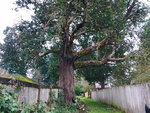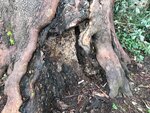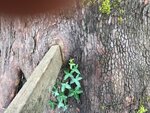


In an alley one block north of Bigelow Park in NE Olympia, the biggest and likely oldest Madrona tree in Thurston County is in declining health, but still breathtakingly beautiful.
Its location at the edge of a little-used alley has undoubtedly contributed to its longevity. No one has spread fertilizer or weed-killer near it, dug up the soil around its roots, or watered it during the summer when it needs to be dry.
Like the rest of us, this tree is not immortal, but it has probably outlived its estimated 200- to 300-year life expectancy.
That is unusual, especially in an urban or suburban environment, where Madrona trees and humans don’t typically get along well.
Many homeowners don’t like madronas because they are always shedding something. In the spring, they bloom and then shed their blossoms. In the summer and fall, they grow new leaves and shed their old ones. They constantly shed their bark, just like snakes shed their skins when they outgrow them. But Madrona’s shiny leaves, abundant white blossoms, and bright red berries – not to mention its ever-changing, multi-colored bark – make it worthy of wonder and admiration.
It is possible for gardeners to peacefully co-exist with madronas if they can provide the conditions Madronas are accustomed to in the wild: dry, rocky soil, often on a hill or even at the edge of a cliff if you happen to have one. They also like to be surrounded by the native grasses and shrubs that are their neighbors in the wild, but maybe not if you have to disturb their roots to plant them.
The continuing encroachment of suburbs, pavement, and pollution have shrunk Madrona’s specialized habitat, and the spread of diseases may threaten some populations in the wild, where it has thrived at the edge of relatively dry forests and along undeveloped shoreline cliffs all around Puget Sound. We don’t know yet how it will be affected by climate change. So, Madronas need organized and energetic advocates.
Fortunately, in 2016, a partnership between the Washington State University Ornamental Plant Pathology Program and the Seattle Parks and Recreation Department launched an initiative called the Arbutus ARME. They hope to build a range-wide coalition to conduct research and public support for conserving the species both in the wild and in parks and yards. Some of them are also collecting and planting seeds to grow more Madronas.
Madronas are unlike any other native trees. They have such deep roots that they can put out big, heavy branches that hang over the edge of cliffs. They bend and twist in every direction. Their wood is dense and hard, and famous for making firewood that burns hot and long. Their bark’s ever-changing colors and textures could make an artist swoon. And their perpetual shedding and renewal – of bark, flowers, leaves and berries – is raw material for poets, and possibly psychologists.
Tidy people may not like them, but Madronas lift the spirits of the rest of us. They are an essential part of what makes South Puget Sound our home.
Although West-of-the-Cascades Washingtonians may think of Madronas as “our” native tree, its range extends from southern British Columbia, where it is called Arbutus, to southern California, where it is called Madrone.
Wikipedia notes that “According to the Sunset Western Garden Book, in the United States, the name "madrone" is more common south of the Siskiyou Mountains of southern Oregon and Northern California and the name "madrona" is more common north of the Siskiyous.”
As a provincial Northwesterner who values local tradition, I resist the northward creep of Madrone.
Our Elder in the alley was living long before the neighborhood around it was built, and before settlers arrived in Olympia about 175 years ago. It silently teaches us lessons that can’t be expressed in words, but can be felt in the heart when we stand beneath it. It is a magnificent Madrona, a part of our local heritage.
Jill Severn writes from her home in Olympia, where she grows vegetables, flowers, and a small flock of chickens. She loves conversation among gardeners. Start one by emailing her at jill@theJOLTnews.com
5 comments on this item Please log in to comment by clicking here
GinnyAnn
Like you, I treasure Madrona trees. They do symbolize the Pacific Northwest to me. I love seeing them towering and twisting above a road, especially when the white blossoms are showing. I love their flaky bark. I used to love climbing on the "saddles" created by the horizontal trunks when I found them in the woods when I was a kid. I'm so glad this mighty Madrona has survived the encroachment of humans into its territory and hope we don't disturb it any further. I regret the loss of so much of our beautiful trees' habitat already. The loss of the specific Madrona habitat to development will never replace it's unique contribution to the environment.
Saturday, March 2 Report this
SecondOtter
"Our" native madrone (does it really matter whether I call it a madrone or madrona? No.) , Arbutus menziesii, is probably one of my favorite trees. I never thought of them as being "messy"..We have two growing on the edge of a played out gravel pit near my home, fitting the 'dry, rocky soil, often on hill'. During the snowfall of 15 Feb 24, one of them took one heck of hit, the weight of the snow breaking off a significantly thick limb.
I love the red, bare skin of the tree. Sometimes I go and just stroke the wood, thinking how smooth and lovely it is.
So many trees are being cut down to make way for more housing. IF the developer replaces trees, he uses non natives such a London plane tree, and never one that puts out seeds or nuts. It's sad. And the developer just throws the sapling into a hole and calls it good. By the time the tree has died due to lack of care, the developer is long gone.
Go ahead and call me a tree hugger, I wear that name proudly.
Sunday, March 3 Report this
SecondOtter
I am not familiar with this area, but someone, PLEASE. Go and pull that dammed english ivy growing at the base of the tree. Ivy will kill it. Slowly, by strangulation, but surely.
Tuesday, March 5 Report this
GinnyAnn
Spot on. English Ivy is an invasive species that kills the trees and shrubs it envelops and strangles. It's tough to root out and can cause a horrible rash on the skin of people sensitive to its toxic coat. I hate seeing ivy climbing up a grand old maple tree in the woods. People may find the ivy pretty in the garden, but it doesn't stay where planted. It finds the nearest tree or shrub and kills it. Nasty stuff.
Tuesday, March 5 Report this
SecondOtter
You are right, Ginny Ann. Another thing that people don't seem to know about english ivy...rats adore it. It's their native habitat, really. In the wild...when 'Norway" or black rats were still wild creatures, english ivy was their home. It provided food and cover from predators.
ANyone who wants to plant or grow ivy in their gardens or around their homes is putting out a 'welcome!" mat to rats.
Tuesday, March 5 Report this